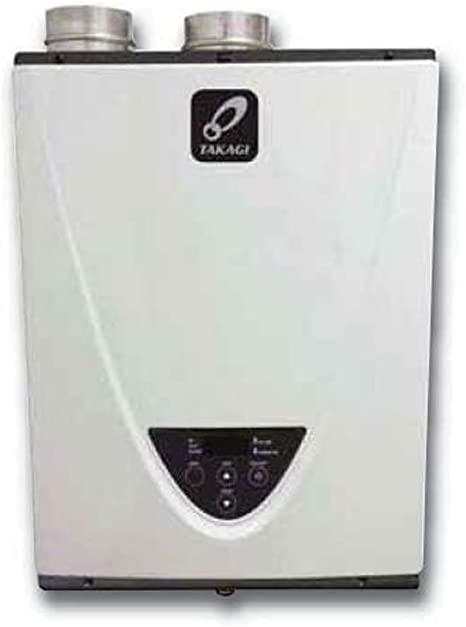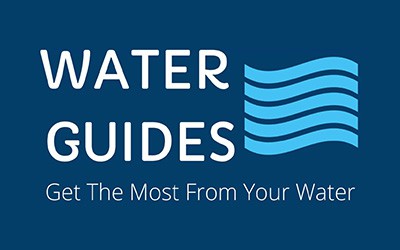Takagi sells itself as a quality-oriented brand. Since 1952, Takagi has strived to be an industry leader by committing themselves to innovation and customer satisfaction. Takagi prioritizes safety, quality, and excellent service in their mission to provide top-quality residential and commercial tankless water heaters. The Takagi brand aims to provide energy-efficient tankless water heaters that continue to provide value to the consumer years after the original installation.
Takagi’s key selling point for their tankless water heaters is its durability. The first heat exchanger is designed from heat-resistant copper alloy, which provides vital resistance to the effects of erosion and result in leakage. The secondary heat exchanger (only available in condensing models) is made from a high-quality stainless steel. The stainless steel heat exchanger is necessary to avoid corrosion. The two heat exchangers create a unique balance that maximizes heat transfer while minimizing the damage the high heat can cause. These two components result in a more durable tankless water heater.
Contents
Takagi Tankless Water Heater Product Line Reviews
Takagi has a handy guide on their website to help you find the right tankless water heater for you. It lists both condensing, non-condensing units , and commercial units, and provides a clear graphic detailing what the capacity is across different units. It further breaks down the graphic into warmer climates and cooler climates, so that customers in any region can adjust their expectations accordingly and find the right fit for their needs.
Takagi created an additional table to demonstrate the flow rate across all the different product lines it offers, using the rise in temperature to compare the gallons per minute (GPM).
H3 Series – Condensing Tankless Water Heaters
Takagi has several tankless water heaters under their H3 Series namely the H3, H3M, H3J, and H3S.
In cooler climates, the H3M has a capacity of accommodating 1.5 shower heads. The H3J and H3S can accommodate 2.5 shower heads. The H3 can accommodate up to 3 shower heads.
When it comes to flow rate, the H3 Series can meet the needs of most medium-to-large homes. The H3M and H3J both have a max 6.6 GPM. The H3S offers a max 8.0 GPM, and the H3 offers the highest flow rate in this series at 10.0 GPM.
The H3M is specially designed to fit into small spaces and utilizes PVC venting to decrease installation costs. It meets the Energy Star standard and measures at 90% efficiency. It weighs a mere 44 lbs.
The H3J utilizes commercial grade copper alloy for the heat exchanger, which allows this model to be qualified for an Energy Star and measures at 94% efficiency. This is a substantially heavier model, weighing 71 lbs. The H3S is nearly identical to the H3J model, except that the H3S is slightly more powerful (the H3S features 180k maximum British Thermal Units, or BTUs, whereas the maximum for the H3J is 160k BTUs).
The H3 water heater has the best value-to-size ratio. Featuring a maximum of 199k BTUs and measuring at 93% efficiency, this Energy Star unit is only 59 lbs. This water heater is perfect for the busy or particularly large household.
The units in the H3 product line range in price from $650-$1100, depending on the model, size, and power.
Takagi Tankless Water Heaters vs. Other Brands
Takagi vs. Noritz
Takagi and Noritz are strong market competitors, with customers of each brand reporting high customer satisfaction. Both brands tout their innovation, quality, and eco-consciousness. Both offer similar warranties for comparable water heater models. However, Takagi offers an additional one-year warranty on labor. Noritz, on the other hand, offers an impressive 25-year heat exchanger warranty on some tankless water heater models.
Noritz tankless water heaters are priced just slightly higher than Takagi water heaters for comparable models. Takagi was established a little earlier than Noritz (1981), but that doesn’t seem to have affected Noritz’s brand reputation in the water heater industry. Perhaps the biggest difference is that many Noritz tankless water heaters can be used both indoors and outdoors.
Takagi vs. Bosch
Takagi tankless water heaters have a slightly higher price range than Bosch tankless water heaters for models with similar technical specifications.
Customers who purchased a Takagi water heater report in their product reviews that they are very satisfied with their purchase, noting the durability and efficiency of Takagi water heaters. Many are also impressed with the water flow rate of their units (max 10 GPM!). Customers tend to be split with Bosch water heaters, either reporting very high satisfaction with their unit or reporting issues within the first year after installing a new water heater.
Bosch has a competitive warranty on their products, but still falls short of Takagi. While both offer a 15-year limited warranty on products and a five-year limited warranty on replacement parts, Takagi takes the extra step of offering a one-year warranty on labor.
Here, Takagi offers a little more than Bosch and appears to be a little more reliable in their quality and performance. Customers who can afford to spend a little more on Takagi will likely find themselves saving money and time by not having to replace or repair their Bosch water heater.
Takagi vs. Rheem
Rheem is considered a solid, affordable, mid-level tankless water heater brand. With tankless water heaters ranging in price from $200 to $3600, it is highly likely that a consumer will be able to find a water heater that fits their specific needs.
For models with a similar price point, Rheem and Takagi models are neck and neck when it comes to technical specifications. As a comparison, here is a Rheem Tankless Water Heater and here is a Takagi Tankless Water Heater.
Both models offer excellent flow rates (max 9.5 GPM for Rheem, max 10 GPM for Takagi). Both operate on natural gas. Both are competitively efficient (94% for Rheem, 95% for Takagi). The Takagi model is slightly smaller and weighs less than the Rheem, but only barely. Many of their technical specifications are similar or incredibly close. Whether you choose to go with Rheem or Takagi, you are very likely to be satisfied with whichever one you purchase.
Takagi vs. Rinnai
Takagi and Rinnai are both manufactured in Japan, so they often share similar components, features, and warranties. Both brands produce highly efficient models, so consumers can expect long-term cost savings on their water bill with either brand of tankless water heater, even despite the high upfront cost.
Rinnai offers a different venting system than Takagi: Rinnai tankless water heaters have a built-in condensation trap. Because of this condensation trap, Rinnai tankless water heaters have better durability and a longer lifespan.
Rinnai also offers slightly better features for a similar price point. For those who are technologically savvy or merely enjoy the convenience technology can provide, Rinnai will likely be the preferred brand.
Takagi vs. Navien
Navien tankless water heaters are made in South Korea and is a fairly new brand to the U.S.A. Navien tankless water heaters are generally the most expensive tankless water heaters on the market (all other technical specifications remaining the same). The brand justifies the high price point by touting their high level of efficiency and excellent performance. Navien also incorporates many advanced technologies in their products that provide real benefit to consumers.
Both brands offer similar flow rates and thermal efficiency rates, but Takagi manufactures models that are slightly more affordable for the average consumer. For the consumer on a budget, Takagi offers similar features and great quality for a lower price.
Takagi Tankless Water Heater Cost
Takagi tankless water heaters typically fall within a narrow price range; many units cost $850-$1,100. Takagi water heaters are not the most or the least expensive units on the market; in fact, they fall neatly down the middle. Some models of Takagi water heaters can be purchased on Amazon (here and here, for example).
Takagi itself does not sell their products on their website, but rather direct customers to search for a licensed distributor, service provider, or dealer in their area using their search function here.
Takagi Tankless Water Heater Maintenance
Takagi offers easy-to-access advice when it comes to tankless water heater maintenance. Their FAQ page is full of useful information, such as using a water treatment device to soften hard water and prevent scale and buildup. The brand also suggests periodic flushing to remove any built-up scale.
Takag’s Troubleshooting & Repair page is another excellent resource that identifies common service problems and how to mitigate the issue (if possible). It also provides possible solutions and tips to prevent you from causing further damage to your tankless water heater.
Like all tankless water heaters, Takagi water heaters need regular (usually annual or biannual) maintenance to inspect all components, flush the tankless water heater, and clean your unit, to ensure your water heater continues to run in optimal condition.
Takagi Tankless Water Heater Parts
Takagi makes it easy to obtain replacement parts on their site. They provide a current replacement parts list in both excel and PDF format, and then direct you to a different website to place your online order.
Takagi is also available to take phone orders (although they require a minimum order amount of $50). They accept Mastercard, Visa, Discover, and American Express. In order to place an order over the phone, you can reach Takagi at 1-800-433-2545.
Takagi Tankless Water Heater Service
Takagi notes that many regions have factory trained service providers, and makes it incredibly easy to find one near you. The results include the name and address of the service provider, contact information, and distance from your location. It also includes information about the different types of services each technician provides (for example, some businesses only offer installation, while others might do installation and repair or maintenance).
Takagi Tankless Water Heater Warranty
Takagi insists that their tankless water heaters must be installed and serviced by a licensed plumber, gas fitter, or professional service technician, because improper installation (or installation by an unqualified person) will void their warranty.
Nonetheless, Takagi offers a 15-year warranty for residential tank heat exchangers and a five-year warranty for all other parts (except for fuses). They offer only a 10-year warranty for commercial water heaters and a five-year warranty for all other parts.
Takagi Tankless Water Heater Customer Service
Takagi clearly strives to provide excellent customer service. They have live call centers with experienced professional technicians for 12 hours a day (5AM to 5PM PST).
Phone Number: 888-882-5244
Takagi also makes it easy to contact them online with a form here. However, they don’t provide any sense of how long it would take for a customer service agent to respond to any comments or questions, and they don’t offer any other means by which they can be contacted (e.g. e-mail or fax).
Customer Reviews/Perception
Overall, many customers are happy with their Takagi tankless water heater and would even recommend them to a family or friend. Customers often mention that the unit was easy to install, the unit works well, and are impressed by the performance of their Takagi unit.
However, a few customers also expressed legitimate criticisms: many Takagi tankless water heaters are not designed for high volume use, and are therefore not often well suited to large homes.
Ultimately, Takagi has worked hard for many years to establish its reputation as a quality provider of tankless water heaters, and customers are regularly pleased with the performance of their water heater and the value they receive from it. A consumer interested in installing a tankless water heater would likely be satisfied with a unit from Takagi.

